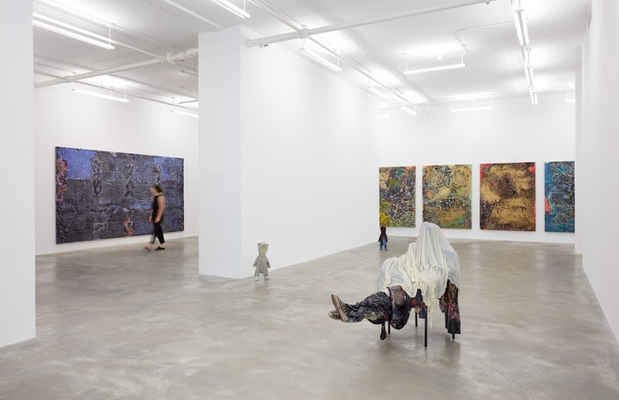Kevin Beasley “Reunion”
Casey Kaplan

[Image: Installation view: Kevin Beasley "Reunion" (2020) Casey Kaplan, New York. Photo: Jason Wyche]
This event has ended.
Every August, Beasley returns home to Virginia to attend his family’s annual reunion in Valentines (roughly one hundred miles from his hometown of Lynchburg), held on a rural property that has been owned and occupied by his extended family for multiple generations. The family’s deep-seated tradition of gathering is centuries-old and has been a consistent staple for several decades. However, as a result of the ongoing global pandemic, this summer’s reunion was cancelled for the first time in current memory, a decision made with care in order to preserve the family.
Beasley continues to consider his own place within the property’s ancestral past, and more generally, within the context of black land ownership in the South. With an indelible connection to the land where the reunion is held and the relatives who participate, Beasley sources materials of cultural and personal significance for use in his multi-media practice. Beasley’s materials span from raw cotton (harvested in Valentines by a farmer who leases the land), to elaborately patterned polyester housedresses sourced from a former Harlem dress shop that was patronized for decades by his grandmother and great-grandmother. The cotton and the dresses have been altered and manipulated. Then, ultimately cast and molded to form a body of sculptures that acknowledge the complex, shared histories of the broader American experience as it relates to the history of the production of cotton, as well as to Beasley’s own connection to this location, surrounded by family and steeped in generational memories.
“The Road,” a monumentally-scaled “slab” comprised primarily of polyurethane resin and raw Virginia cotton, exists as the entry point into this exhibition, both physically and metaphorically. The term “slab” has been established by the artist to represent sculptural formations that reflect on ancient stone reliefs (specifically 9th c. BCE Assyrian reliefs that depict battle or courtly scenes and religious rituals in rich detail and highly schematic imagery). “The Road” is connected in both form and narrative to the three “slabs” included in Beasley’s critically acclaimed 2018-19 solo exhibition at the Whitney Museum of American Art, “A view of a landscape,” organized by Christopher Y. Lew. While the works at the Whitney chronicled specific moments that led to Beasley’s procurement of a cotton gin motor from Maplesville, Alabama in 2012, “The Road” is the culmination of this journey, bridging past, present, and future.
In a leap from abstraction towards pictorial narrative, “The Road” depicts Beasley’s familiar car journey from Lynchburg to Valentines. A golden sunset comprised of raw and dyed cotton, altered t-shirts, and cut-up rubber tires hovers in the near distance, just beyond the horizon yet grounded to the winding black tarmac. Rays of sunlight, articulated by brightly dyed du-rags and copper, extend into a dyed-blue cotton sky dotted with birds made from guinea fowl feathers (a symbol of protection among native African tribes) illuminating a field of varying shades of altered green-colored housedresses where two child-like figures frolic.
“The Road” is a freestanding sculpture in the round. On its verso, the road itself is depicted in deeply saturated black hues of dyed cotton along with altered rubber tires that ghostly render the profile of a moving vehicle. Historically, the road is a charged setting for social movements, from strategy meetings that occurred in cars during the Civil Rights Movement to John Lewis’ epic 1965 journey by foot over the Edmund Pettus Bridge in Selma to the marching protestors Beasley spotted this summer along Highway 95 South, while journeying back to Valentines from Harlem.
Lining the gallery walls are a new series of elevated, wall-based “slabs.” Originally conceived in 2017, Beasley’s “slabs” began as large-scale square and rectangular structures that rested on the floor, flush to the wall with the potential to be rotated. However, these new elevated “slabs” hang on the wall, occupying the traditional space of painting, and for the first time contain images printed onto t-shirts derived from photographs Beasley shot of the family property in Valentines. Within a Rorschach test-like composition of absent bodies, t-shirts are coated in resin and combined with pine cones, soil, and twigs culled from Virginia. Images and material are interchangeable and reference the same origin. Surfaces read as topographical and bodily, straddling the line between abstraction and representation.
Nearby, a reclining figure rests cloaked in muslin, a thin material used for covering one’s body in funerary ritual. The form is reminiscent of Beasley’s series of “ghosts” begun in 2015, in which invisible apparitions are made visible through a process of cutting, sewing, and finally coating clothes in fast drying resin, draping them over foam spheres that serve as temporary molds. As the resin begins to cure, Beasley removes the molds and the garments remain solidified in space - hardened, hollow shapes of human figures. Here, a greater sense of presence prevails, as if the artist himself is unwinding on the porch, taking a moment for himself as his family gathers in the distance.
Media
Schedule
from September 10, 2020 to October 24, 2020